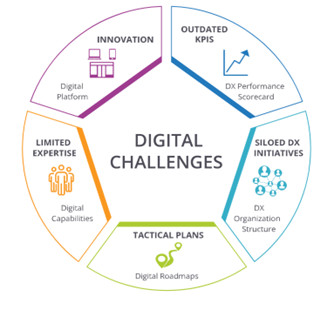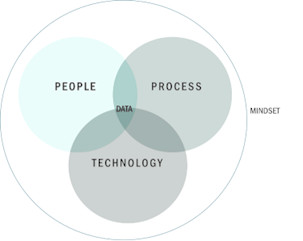When a company undergoes digital transformation, it integrates new technology throughout its operations in order to spur substantial shift. The most important fact for doing this is to improve effectiveness, enhance adaptability, and create brand-new value for the shareholders, customers and even employees.
Each business has its own unique path to digital transformation, and there are several techniques that business might pursue. For instance, in order to provide a better service to its customers, a business might adopt new technologies such as cloud computing and artificial intelligence. Alternatively, it may restructure its supply chain to include machine intelligence in a more substantive fashion. A corporation may even make spot-on forecasts about the products customers will demand in a few months’ hence, adjust operations to meet consumers’ demands.
Key attributes of digital transformation
If a firm is enthusiastic in revamping its business practices and operational procedures, digital transformation is a great solution. Clearly, the only open question is how? The benefits and drawbacks of digital transformation are similar to those of any other technical innovation. How, therefore, can a company make sure it follows the safest procedures possible while putting these plans into action? The answers to these questions may be summed up in a few words: key attributes of the digital transformation. The following are the key attributes of a successful digital transformation:
Culture change and communication. We are undergoing a time of profound cultural change. Customer and employee aversion to change is a common obstacle to any kind of transition. An organization’s culture is the bedrock of every effective digital transformation initiative. That’s why it’s a good idea to have your staff ready for it ahead of time. This may be done through a clear and concise communication such as:
• Having a conversation with the staff regarding the digital transformation plan and how it will improve the organization as a whole.
• Equipping the company’s workforce by holding seminars and workshops with them.
• Demonstrating how important it is to harmonize the company’s culture with staff.
Leadership and strategies involved. It may appear apparent that a digital transformation strategy would benefit from a well-thought-out game plan, yet this crucial element is frequently disregarded. How and who comes up with the approach, though, is what really matters.
Digitizing or digitalizing your company is possible with a fundamental plan and the appropriate tools but change calls for the right mental attitude and leadership. Therefore, the most fundamental and significant part of a successful digital transformation plan is strategy paired with the appropriate leadership.
By combining visionary leadership with the right digital transformation strategy, you can improve the efficiency, effectiveness, cost-effectiveness, and timeliness of your company’ transition while staying true to its core values.
Streamlined and transparent business operation. Achieving an effective digital transformation requires well-defined operational procedures. Such procedures not only generate crucial information for making decisions, but they also help a business adapt quickly to the requirements of its customers and share knowledge effectively among its employees.
Optimized process. How often do you find yourself in the midst of a task, wishing there was a faster or easier method to accomplish it? Every company has a profusion of practices and procedures that may be improved upon streamlining operations.
Therefore, it’s imperative to formulate the digital transformation plan with organizational continuous improvement in mind. The plan has to optimize corporate processes while still achieving both consumer and internal objectives. In order to maximize production, the digital transformation plan must include all related company operations. You need to optimize company processes, and you also need to make excellent use of the information you’ve collected over the years.
Challenges in digital transformation

(Source: Aisha Javed, 2019)
While digital transformation empowers businesses to explore exciting new chances for creativity and expansion, it also requires careful analysis and poses challenges when it comes to redesigning fundamental elements of a company’s operations. There are several challenges that businesses face during their digital transformation, which include:
Sophisticated technology and software. Commercial software systems always have a higher degree of complexity. Adapting to new technology may seem overwhelming at first. This is a serious impediment for businesses undertaking digital transformation, both in terms of the user experience and the ease with which new systems may be implemented and integrated with existing datasets. Managers ought to think about this at the beginning of a digital transformation and look for the most user-friendly, unified technology to implement.
Inadequate digital transformation strategy. The transition from conventional systems and outdated IT systems to modern technology prompts the question: why? Is there a need (or a plan) to introduce cutting-edge technology at your company? Is your organization prepared to move smoothly from the old system to the new one? These are all important considerations prior to initiating the digital transformation process. Without a well-thought-out plan, a digital transformation will inevitably fail. Do not, however, fall for empty rhetoric and cliches. It’s important to identify problem areas and upgrade points inside the company.
Poor data management. One of the key cornerstones of digital transformation is the collection and use of consumer data. It’s a powerful tool for learning about your customers’ tastes, habits, and possible future actions. You may probably presume that the manner in which you record and arrange this data is important. But it might be challenging to aggregate this information and make it centrally accessible if you are still using isolated technologies. That may be the case if all of the information is kept at a single facility. It is necessary to scale things down significantly in order to address these difficulties. What specific information about the clientele is required for optimal service? Establishing a list to serve as a guide for the data analysis might be the best option to tackle such an issue
Destructive technology advancements. The world of digital technology is dynamic and ever-changing. The only thing that can be said with absolute certainty about the present is that it is continuously shifting. There have been significant shifts in how we consume music, as well as how we use the internet for shopping and social networking in the last several years. Many large firms are unable to adopt cutting-edge innovative products because they are stuck on obsolete, existing systems. Equipment that used to involve human labor is now unnecessary due to advancements in fields of digital technology such as robots, AI, and machine learning. Examples of the success that has resulted from the introduction of disruptive technologies in the past decade include the widespread use of ATMs, the rise of self-service machines, and the rise of online ordering. Companies need to present a comprehensive strategy to address the scarcity of expertise in these areas.
Enablers and success factors for digital transformation

(Source: Idoia Hidalgo, 2022)
Digital transformation requires enough resources to ensure a seamless process that will see the organization succeed in its operations. However, it is always crucial to know the key factors that can effectively facilitate this process. Below are some of the crucial enablers that can enable digital transformation to be successful and seamless:
People. Every facet of a digital plan relies heavily on humans. Employees are one of the elements that create distinct value propositions for a company, whether via the simplification of operational activities or the maximization of the use of current tech and data collected. The contemporary scarcity of IT expertise highlights the need to invest in both the present and future workforce. Companies may remain ahead of the curve by forecasting their staffing needs. Companies must prioritize keeping their present staff by capitalizing on retention methods like training and education. The first step toward digital success is to ensure the company has the greatest staff possible.
Good leadership and culture. For a company to undergo a significant digital transformation, its leadership and organizational culture should reflect the characteristics of a winning team, one in which individuals are encouraged and supported to contribute their full potential.
Articulate processes. The processes that companies use to get things done also need to be streamlined for the digital revolution. It is essential for businesses to avoid siloing, which is something that firms are at risk for due to the fact that technology is interdisciplinary in nature. Siloing might lead to time wastage, unproductive research, and missed opportunities for innovation. Due to the pervasive nature of digital frameworks, it is crucial to encourage teamwork across departments and provide clear processes. Lastly, in order to improve a company’s digital initiatives, it is crucial to have a proper definition of duties as well as techniques within which employees may communicate.
Data. There would be no technological progress without data. No amount of digital work will be as effective as it may be without the proper management of information, data governance, and digital strategy. For accurate decision-making and performance, data is the binding agent linking technology, people, and processes. Therefore, data is important in the formation, implementation, and optimization of any digital transformation. To make sure the proper groups are linked and have access to data analytics, it’s important to strategically put up an efficient data and governance approach. Ideas developed by data teams in tandem with top management should be shown in simply digestible dashboards.
About the author:
Arindam Mukherjee is an IT supply chain architect and published author in leading supply chain publications. He can be reached at [email protected].
SC
MR


Latest Supply Chain News
- Few executives believe their supply chains can respond quickly to disruptions
- Technology’s role in mending supply chain fragility after recent disruptions
- Tech investments bring revenue increases, survey finds
- Survey reveals strategies for addressing supply chain, logistics labor shortages
- Israel, Ukraine aid package to increase pressure on aerospace and defense supply chains
- More News
Latest Podcast

 Explore
Explore
Topics
Business Management News
- Few executives believe their supply chains can respond quickly to disruptions
- Technology’s role in mending supply chain fragility after recent disruptions
- Survey reveals strategies for addressing supply chain, logistics labor shortages
- How CPG brands can deliver on supplier diversity promises
- How S&OP provides the answer to in-demand products
- AI, virtual reality is bringing experiential learning into the modern age
- More Business Management
Latest Business Management Resources

Subscribe

Supply Chain Management Review delivers the best industry content.

Editors’ Picks





